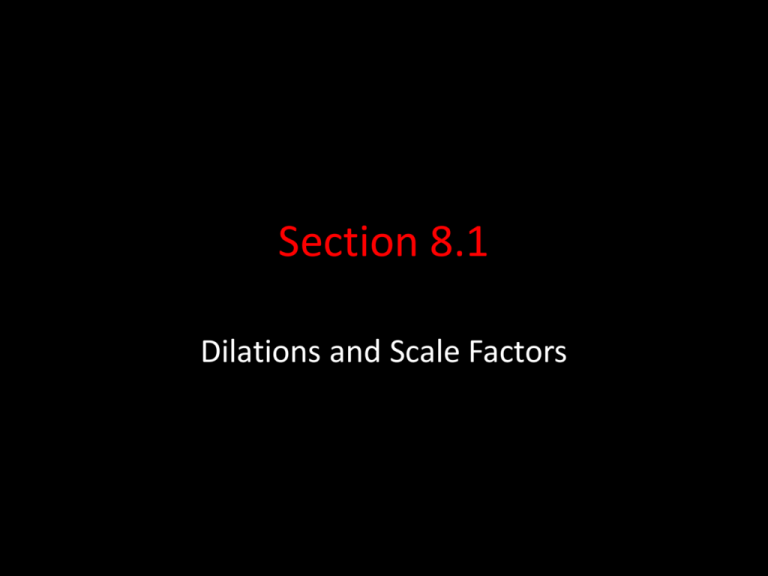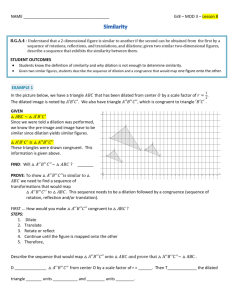Section 8.1 - Monroe County Schools
advertisement

Section 8.1 Dilations and Scale Factors Dilations • A dilation is an example of a transformation that is not rigid. Dilations preserve the shape of an object, but they change the size. • A dilation of a point in a coordinate plane can be found by multiplying the x- and ycoordinates of a point by the same number, n. • The number n is called the scale factor of the transformation. Dilations • What are the images of the points (2, 3) and (-4, -1) transformed by the dilation of D(x,y) = (3x, 3y)? • (3 · 2, 3 · 3) [3 · (- 4), 3 · (- 1)] • (6, 9) image (- 12, - 3) image • The scale factor is the multiplier 3. Using Dilations • The endpoints of a segment (1, 0) and (5, 3) and a scale factor of 2 is given. • Show that the dilation image of the segment has the same slope as the pre-image. • m = y₂ - y₁ slope x₂ - x₁ • m = 3 – 0 = 3/4 5–1 (2 · 1, 2 · 0) & (2 · 5, 2 · 3) -> (2, 0) & (10, 6) image • m = 6 – 0 = 6/8 = 3/4 10 – 2 Using Dilations • Find the line that passes through the pre-image point (3, - 5) and the image that is found by a scale factor of – 3. [- 3 · 3, - 3 · (- 5)] -> (- 9, 15) image m = y₂ - y₁ x₂ - x₁ slope • m = - 5 – 15 = - 20/ 12 3 – (- 9) • m = - 5/3 • y – y₁ = m(x – x₁) point-slope form • • • • • • y – 15 = (-5/3)(x – (- 9)) y – 15 = (-5/3)(x + 9) y – 15 = (-5/3)x – 15 + 15 + 15 y = (-5/3)x slope of a line Section 8.2 Similar Polygons Similar Polygons • Two figures are similar if and only if one is congruent to the image of the other by a dilation. • Similar figures have the same shape but not necessarily the same size. Polygon Similarity Postulate • Two polygons are similar if and only if there is a way of setting up a correspondence between their sides and angles such that the following conditions are met: • Each pair of corresponding angles are congruent. • Each pair of corresponding sides are proportional. Polygon Similarity • Show that the two polygons below are similar. A AB = BC = AC EF FD ED 5 3 E B 4 9 F C 3 = 4 = 5 9 12 15 15 12 D Each ratio is proportional. △ABC ~ △EFD ~ means similar Properties of Proportions • • • • • • • • • Let a, b, c, and d be any real numbers. Cross-Multiplication Property If (a/b) = (c/d) and b and d ≠ 0, then ad = bc Reciprocal Property If (a/b) = (c/d) and a, b, c, and d ≠ 0, then (b/a) = (d/c). Exchange Property If (a/b) = (c/d) and a, b, c, and d ≠ 0, then (a/c) = (b/d). “Add-One” Property If (a/b) = (c/d) and b and d ≠ 0, then [(a + b)/b] = [(c + d)/d]. Section 8.3 Triangle Similarity Triangle Similarity • AA (Angle-Angle) Similarity Postulate: • If two angles of one triangle are congruent to two angles of another triangle, then the triangles are similar. • SSS (Side-Side-Side) Similarity Theorem: • If the three sides of one triangle are proportional to the three sides of another triangle, then the triangles are similar. • SAS (Side-Angle-Side) Similarity Theorem: • If two sides of one triangle are proportional to two sides of another triangle and their included angles are congruent, then the triangles are similar. Triangle Similarity • Prove each pair of triangles are similar. A L 8 20 55° J 6 K D 62⁰ 47⁰ E M F 62 + 47 + < E = 180 109 + < E = 180 < E = 71 R 62⁰ 71⁰ 55° N C 15 B 55° = 55° 20 = 8 20(6) = 15(8) 15 6 120 = 120 proportional < D ≌ <M and < E ≌ < R △ACB ~△LJK by SAS Similarity △DEF ~ △MRN by AA Similarity Triangle Similarity • Prove the two triangles are similar. X 10 T Z 7 8 10.5 12 Y G GH = 15 TH = 10.5 GT = 12 ZX 10 YX 7 ZY 8 15 = 1.5 10.5 = 1.5 12 = 1.5 10 7 8 H 15 △GTH ~ △ZYX by SSS Similarity Three sides of one triangle are proportional to three sides of another. Section 8.4 The Side-Splitting Theorem Side-Splitting Theorem • A line parallel to one side of the triangle divides the other two sides proportionally. • Two-Transversal Proportionality Corollary • Three or more parallel lines divide two intersecting transversals proportionally. Side-Splitting Theorem • Example: H 20 D 5 F 22 HD = DF HE EG 20 = 5 22 x E X G 20x 20x 20x 20 x = 22(5) = 110 = 110 20 = 5.5 Two-Transversal Proportionality Corollary • Example: 5 x 9 5 = x 9 3 3 5(3) = 15 = 15 = 9 1.66 = 9x 9x 9x 9 x Section 8.5 Indirect Measurement and Additional Similarity Theorems





